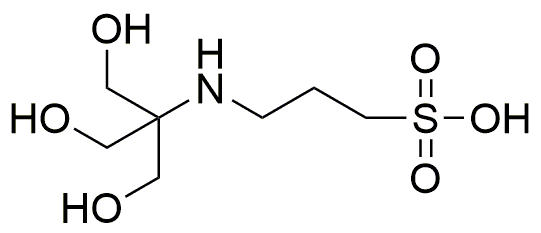TAPS is widely utilized in research focused on:
- Biological Buffering: TAPS is commonly used as a buffering agent in biological and biochemical applications, helping to maintain stable pH levels in experiments involving enzymes and proteins.
- Cell Culture Media: It is an essential component in cell culture media, providing optimal conditions for cell growth and viability, particularly in mammalian cell cultures.
- Electrophoresis: TAPS is employed in gel electrophoresis, facilitating the separation of nucleic acids and proteins, which is crucial for molecular biology research.
- Pharmaceutical Formulations: In the pharmaceutical industry, it is used to formulate drugs, enhancing solubility and stability, which can improve therapeutic efficacy.
- Analytical Chemistry: TAPS serves as a reagent in various analytical techniques, aiding in the detection and quantification of biomolecules, thus supporting quality control processes.
General Information
Properties
Safety and Regulations
Applications
TAPS is widely utilized in research focused on:
- Biological Buffering: TAPS is commonly used as a buffering agent in biological and biochemical applications, helping to maintain stable pH levels in experiments involving enzymes and proteins.
- Cell Culture Media: It is an essential component in cell culture media, providing optimal conditions for cell growth and viability, particularly in mammalian cell cultures.
- Electrophoresis: TAPS is employed in gel electrophoresis, facilitating the separation of nucleic acids and proteins, which is crucial for molecular biology research.
- Pharmaceutical Formulations: In the pharmaceutical industry, it is used to formulate drugs, enhancing solubility and stability, which can improve therapeutic efficacy.
- Analytical Chemistry: TAPS serves as a reagent in various analytical techniques, aiding in the detection and quantification of biomolecules, thus supporting quality control processes.
Documents
Safety Data Sheets (SDS)
The SDS provides comprehensive safety information on handling, storage, and disposal of the product.
Product Specification (PS)
The PS provides a comprehensive breakdown of the product’s properties, including chemical composition, physical state, purity, and storage requirements. It also details acceptable quality ranges and the product's intended applications.
Certificates of Analysis (COA)
Search for Certificates of Analysis (COA) by entering the products Lot Number. Lot and Batch Numbers can be found on a product’s label following the words ‘Lot’ or ‘Batch’.
*Catalog Number
*Lot Number
Certificates Of Origin (COO)
This COO confirms the country where the product was manufactured, and also details the materials and components used in it and whether it is derived from natural, synthetic, or other specific sources. This certificate may be required for customs, trade, and regulatory compliance.
*Catalog Number
*Lot Number
Safety Data Sheets (SDS)
The SDS provides comprehensive safety information on handling, storage, and disposal of the product.
DownloadProduct Specification (PS)
The PS provides a comprehensive breakdown of the product’s properties, including chemical composition, physical state, purity, and storage requirements. It also details acceptable quality ranges and the product's intended applications.
DownloadCertificates of Analysis (COA)
Search for Certificates of Analysis (COA) by entering the products Lot Number. Lot and Batch Numbers can be found on a product’s label following the words ‘Lot’ or ‘Batch’.
*Catalog Number
*Lot Number
Certificates Of Origin (COO)
This COO confirms the country where the product was manufactured, and also details the materials and components used in it and whether it is derived from natural, synthetic, or other specific sources. This certificate may be required for customs, trade, and regulatory compliance.

